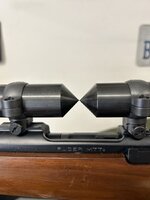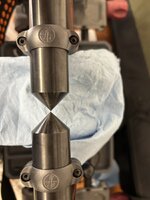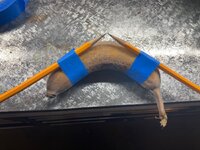What I do when the receiver is way off, like on this gun, is I start with lapping only the lower halves. I get about halfway there first. Stopping to clean and taking note of the wear pattern often. Once I get to about 50-60% contact on the bottom halves, I then install the top halves and lap to 80-90% contact all around.
Navigation
Install the app
How to install the app on iOS
Follow along with the video below to see how to install our site as a web app on your home screen.
Note: This feature may not be available in some browsers.
More options
Style variation
You are using an out of date browser. It may not display this or other websites correctly.
You should upgrade or use an alternative browser.
You should upgrade or use an alternative browser.
Lapping "High end" scope rings?
- Thread starter CampSmith
- Start date
Incorrect. The lower rings are not loose. They are torqued to spec.Guessing the bottom clamps are also loose as you can see the rings (both) tilted to the left at the top, likely making them look worse.
Also i thought this thread was about “high end” rings?
As for the quality of the rings, unfortunately, there arent many options for a Ruger, and in my experience, the Leupold rings (these) are much better than the Ruger OEM ones. The Ruger ring mount system certainly lacks precision, but once trued up, it's as strong as anything out there. It's an integral “dovetail” with a recoil lug in each ring.
Last edited:
BULLBLASTER
Lil-Rokslider
I stand corrected. The way the clamp is rotated makes it look like the rings are not seated. Guess the clamp rotated with torqueIncorrect. The lower rings are not loose. They are torqued to spec.
As for the quality of the rings, unfortunately, there arent many options for a Ruger, and in my experience, the Leupold rings (these) are much better than the Ruger OEM ones. The Ruger ring mount system certainly lacks precision, but once trued up, it's as strong as anything out there. It's an integral dovetail with a recoil lug in each ring.
wapitibob
WKR
From what I have seen, If you get thru the anodizing on 7075 rings you would likely get some aluminum discoloration/deposits on the tube. You can also get marks from the dissimilar surface finish of lapped rings and the usually satin finish on the tube.
You can always put the lapping bar in the rings and then tighten them down on the base. Gives yo the ability to check both ways. Just because the rings are on the base don't mean they are straight.
I had good luck doing this on the Ruger rings.
- Joined
- Jul 29, 2020
- Messages
- 1,103
I have a lapping bar set but have not used them
The alignment bars match up perfectly on my Seekins PMR and Sportsmatch rings so I left them alone
The alignment bars match up perfectly on my Seekins PMR and Sportsmatch rings so I left them alone
Great info! I have always been in the same school of thought.Ok hate to beat a dead horse but I think what I found could be useful to others here. This topic has been argued over on here in numerous posts. Some guys for but most guys against lapping scope rings. Most on here, me included, will say it's definitely not necessary if you buy high end rings. Well Iets just say I agreed with that for years until yesterday. I've never lapped a set of rings. I've mounted more scopes over the years than I can remember. My own, family, friends etc. I've always either used or recommended high end rings and explained the benefits of using them as opposed to using crap. Well I recently purchased a Seekins Precision Havak Element and went with a Leica Amplus 6 3-18x44i 4w to top it off with. I also picked up a set of Seekins 30 mm rings. Before mounting the scope I borrowed my buddies lapping kit for shits and giggles lol. Just to check my "high end rings" I mounted the bottom have of the rings on the rail and torqued them to spec. I then put one of the 30 mm alignment bars on each ring. Guess what? They didn't align perfectly like I thought they would and one of the alignment bars didn't sit flat in the rear ring. I could rock it slightly back and forth. I then chalked the lapping bar put it in the rings installed the caps and tightened them. When I removed the bar that rear ring had only about 30% contact. More contact in the front ring but still less than I ever would've thought. So after all these years I learned something new. I'll never install any set of rings without first checking ever again.
Everything deforms to some degree when you add stress, like tightening bolts. High performance engine blocks have a boring plate torqued onto them before boring the cylinders to simulate the deformation that happens to the block when you torque down the cylinder head. Most commonly its an iron block with aluminum cylinder head/s. Its somewhat counterintuitive to think the aluminum head can cause the block to deform but they absolutely do.
There are far too many different products from different manufacturers with varying tolerances to assume that everything is going to fit perfectly without twisting, warping, or some type of deformation when assembled and torqued, and therefore not need at least a little lapping.
In my particular case, I have a 110 Tactical with an EGW 20MOA rail, Arken Rings, and Bushnell Match Pro scope(rings & scope soon to be replaced). 4 different parts made in 4 different places with at least 4 different sets of tolerances.
There is a tolerance in the 110 receiver shape and where the holes are drilled, there is tolerance in the rail, both as it sits unmounted, and then any deformation that may occur when torquing it onto the action(because of its own tolerances and how those match up against the aforementioned tolerances in the action and screw holes). Then the rings have many tolerances in their construction.
Those tolerances can stack or negate each other, or most likely some combination of stacking and negating. But again to assume that everything lands at a sum of zero is foolish.
Any deformation at the rail is then multiplied by the rings because they are further from the mounting point(so .0005 at the rear point of mounting might be .0015 at the centerline of the rear ring bore, ASSUMING the ring is perfect. Then lets say the rail sits perfectly inline at the front mounting, and assuming the ring is perfect, you have .0015 misalignment between the centerline of the ring bores.
THEN the ring bores might not be perfectly square with the ring mounting, most likely adding even more misalignment OR possibly removing the misalignment but reducing the contact area.
Area 419's method(just an example, others may do the same thing) of boring and honing the bores as a pair HELPS this but you still have the possibility(I would say probability) of mounting those rings on a receiver/rail combo that is less than perfect.
On top of all of that, when lapping, we are assuming that the lapping bar is perfectly straight, perfectly round, exactly the correct diameter, with zero taper. But its far easier to make a perfectly straight, zero taper, 30mm single piece steel bar than perfect scope rings or rail.
Also to be fair, a lapping bar will wear over time(FAR less than the aluminum alloy of the rings, but its still wear) so at some point the lapping bar needs to be replaced.
ALSO alignment bars CAN be misleading. rings could be misaligned and the points still come together(as TaperPin below pointed out, as an extreme example, imagine mounting rings on each end of a banana, the points could come together but obviously the rings arent aligned). If they were doing things right, they would come with a simple piece of flat steel or aluminum(imagine the opposite of an axe blade angle gauge) with the combined angle of the points so that you can make sure the points come together inline and not at an angle.
NONE of this is questioning the quality of the parts used. EVERYTHING has manufacturing tolerances.
There are far too many different products from different manufacturers with varying tolerances to assume that everything is going to fit perfectly without twisting, warping, or some type of deformation when assembled and torqued, and therefore not need at least a little lapping.
In my particular case, I have a 110 Tactical with an EGW 20MOA rail, Arken Rings, and Bushnell Match Pro scope(rings & scope soon to be replaced). 4 different parts made in 4 different places with at least 4 different sets of tolerances.
There is a tolerance in the 110 receiver shape and where the holes are drilled, there is tolerance in the rail, both as it sits unmounted, and then any deformation that may occur when torquing it onto the action(because of its own tolerances and how those match up against the aforementioned tolerances in the action and screw holes). Then the rings have many tolerances in their construction.
Those tolerances can stack or negate each other, or most likely some combination of stacking and negating. But again to assume that everything lands at a sum of zero is foolish.
Any deformation at the rail is then multiplied by the rings because they are further from the mounting point(so .0005 at the rear point of mounting might be .0015 at the centerline of the rear ring bore, ASSUMING the ring is perfect. Then lets say the rail sits perfectly inline at the front mounting, and assuming the ring is perfect, you have .0015 misalignment between the centerline of the ring bores.
THEN the ring bores might not be perfectly square with the ring mounting, most likely adding even more misalignment OR possibly removing the misalignment but reducing the contact area.
Area 419's method(just an example, others may do the same thing) of boring and honing the bores as a pair HELPS this but you still have the possibility(I would say probability) of mounting those rings on a receiver/rail combo that is less than perfect.
On top of all of that, when lapping, we are assuming that the lapping bar is perfectly straight, perfectly round, exactly the correct diameter, with zero taper. But its far easier to make a perfectly straight, zero taper, 30mm single piece steel bar than perfect scope rings or rail.
Also to be fair, a lapping bar will wear over time(FAR less than the aluminum alloy of the rings, but its still wear) so at some point the lapping bar needs to be replaced.
ALSO alignment bars CAN be misleading. rings could be misaligned and the points still come together(as TaperPin below pointed out, as an extreme example, imagine mounting rings on each end of a banana, the points could come together but obviously the rings arent aligned). If they were doing things right, they would come with a simple piece of flat steel or aluminum(imagine the opposite of an axe blade angle gauge) with the combined angle of the points so that you can make sure the points come together inline and not at an angle.
NONE of this is questioning the quality of the parts used. EVERYTHING has manufacturing tolerances.
TaperPin
WKR
- Joined
- Jul 12, 2023
- Messages
- 5,767
They sell a ton of pointed alignment bars, so a lot of guys like them, but if rings were mounted on a banana the points would still align reguardless of what side of the banana it was mounted on.
exactly, thus i want to have mine checked/repointed and possibly have a gauge made.They sell a ton of pointed alignment bars, so a lot of guys like them, but if rings were mounted on a banana the points would still align reguardless of what side of the banana it was mounted on.
TaperPin
WKR
- Joined
- Jul 12, 2023
- Messages
- 5,767
Similar threads
- Replies
- 1
- Views
- 97
Featured Video
Latest Articles
- TT#64 Josh Boyd Elk Hunting Strategies for Every Season
- Aaron Davidson of Gunwerks
- TT#63 Dirk Durham’s Art of Elk Calling
- BIG Buck Stories with the Dirty Giants Podcast
- TT#62 Brian Barney Hunting Bulls without Calling
- Hoyt Alpha AX-2 SD Review
- Kuiu Kenai vs Outdoor Vitals Vario Hooded Jacket Review
- Hoyt RX-9 Ultra Review
- Hunting Vampire Bucks & Building an Optics Kit
- Darton Sequel ST2 35 Review




